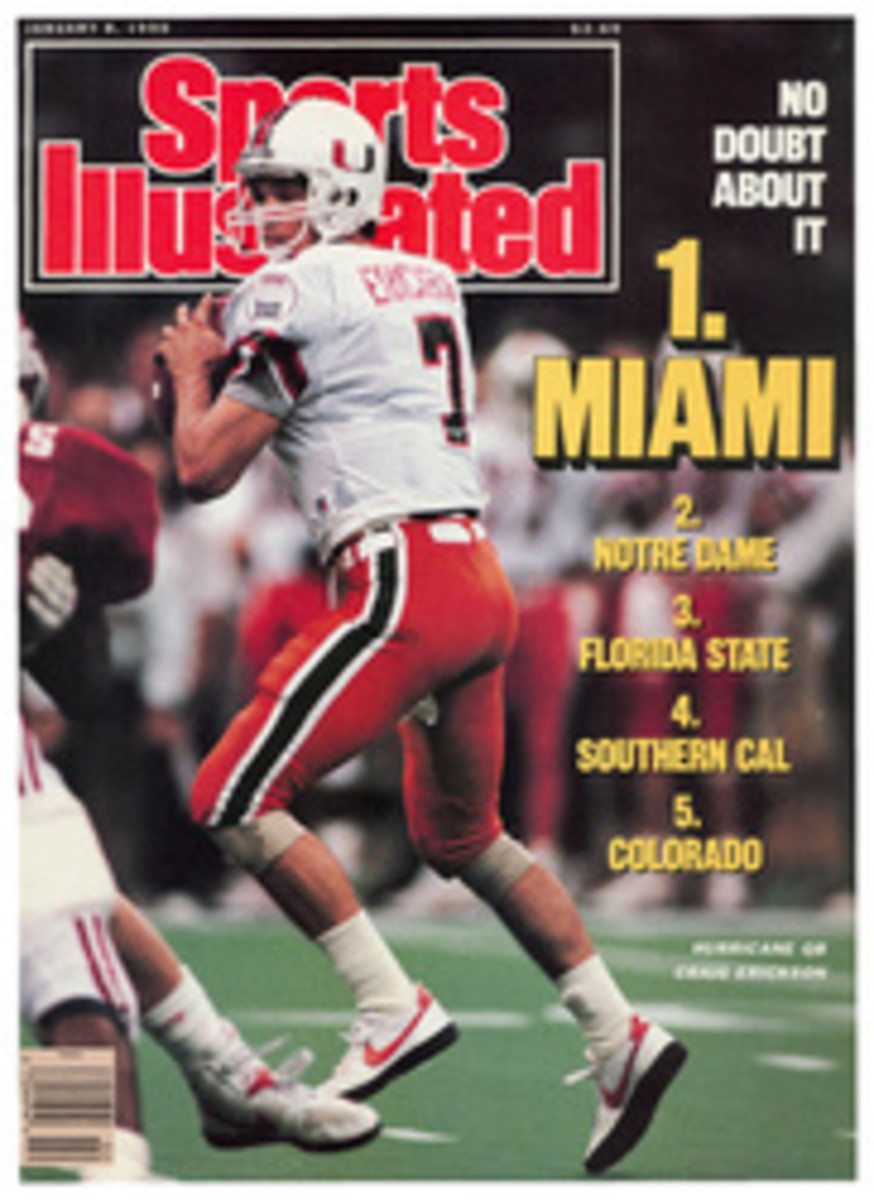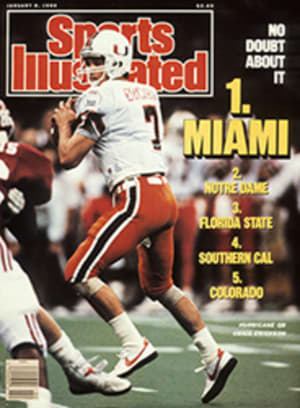
SCORECARD
A PAIR OF BATTLERS
As the New Year began, the world of sports was mourning the deaths of former baseball player and manager Billy Martin, 61, and hockey Hall of Famer Doug Harvey, 65. Both men were compelling, combative figures who played for dynasties of the 1950s—Martin for the New York Yankees, a team he later led to two division titles and a World Series championship in five stormy stints as manager, and Harvey for the Canadiens of his native Montreal. Both men lived hard, drank hard and died too soon.
Martin and his pal William Reedy reportedly spent most of Christmas afternoon imbibing at a restaurant about six miles from Martin's 148-acre spread in Fenton, N.Y. Shortly before 6 p.m., with Reedy, a Detroit bar owner, behind the wheel and Martin on the passenger side, Martin's pickup truck went out of control on an icy downhill stretch of road near Martin's home and slid into a concrete culvert. Neither man was wearing a seat belt. Reedy suffered a broken hip, cracked ribs and cuts; he will recover. Martin smashed through the windshield, fractured his neck and died an hour later in a Binghamton, N.Y., hospital. Police found Reedy's blood-alcohol level to be above the legal limit and charged him with driving while intoxicated.
Scores of notables and thousands of just plain fans flocked to Martin's funeral at St. Patrick's Cathedral in New York City last Friday. He was remembered as a fighter, a fierce little second baseman who couldn't hit much (career average: .257) yet hustled his way into the prepotent Yankee lineup. Fans loved how Martin the skipper sparked his teams and stood up for his players. His overall record of 1,258-1,018 and five division crowns with the Yanks, Twins, Rangers, Tigers and Athletics is one of the better managerial marks in baseball history. New Yorkers seemed to thrive on his constant battles with Yankee owner George Steinbrenner, who fired him four times and pressured him into resigning another time. But Martin's truculence, fed by heavy drinking, also got him into bar brawls and other scuffles. Such incidents hastened three of his Yankee dismissals.
The day after Martin's death, Harvey died quietly in a Montreal hospital, where he had spent the past year receiving treatment for cirrhosis of the liver brought on by a lifetime of heavy drinking. Harvey was the greatest defenseman of a defense-minded era and a cornerstone of the Canadiens' five straight Stanley Cup championship teams from 1956 through '60. He was an extraordinary athlete who played semipro football and minor league baseball. On the ice he was smooth, precise and confident. He often controlled a game's pace, slowing it down to suit Montreal's structured offense. He also concentrated far more than today's defensemen do on defending his own goal. In 19 NHL seasons, beginning in '47-48, he scored only 88 goals, yet was a first-team All-Star 10 times.
Harvey wasn't afraid to mix it up. He was hated in New York because of a 1956 incident in which he speared Ranger center Red Sullivan, rupturing Sullivan's spleen and nearly killing him. And the league establishment resented Harvey because he helped found the NHL Players Association.
Near the end of Harvey's career his investments turned sour, forcing him to hang on into his 40's. When he came up for election to the Hall of Fame, in 1972, he was blackballed, mostly because of his alcoholism. "What they're telling me is that they won't put me in because I'm not averse to sampling the nectar of the gods now and then," said Harvey. The next year, after an outcry from fans and the press, he was named to the Hall.
Harvey and Martin were products of an era in which pro athletes were all but expected to be hard drinkers. Drinking was an act of manhood, and drunkenness was fodder for jokes. "We used to tease each other about whose liver was going to go first," said Martin's old drinking buddy and Yankee teammate Mickey Mantle last week. Alcohol plagued the lives of Harvey and Martin, and it cut them short.
TUBBS THUMPING
That paragon of sportsmanship, Oklahoma basketball coach Billy Tubbs, was at it again last week. After his undefeated (8-0) Sooners demolished hapless North Texas 147-94 to increase their average margin of victory this season to close to 50 points—their biggest rout as of last weekend was a 146-51 win over mighty Northeastern Illinois on Dec. 2—Tubbs had the grace to gripe about his team's performance. "I thought we were terrible," he told reporters afterward, which must have made the North Texas players feel pretty terrible, too. "Offensively we did all right, but defensively in the first half we weren't in the game. We weren't making things happen with our defense."
Everyone is duly impressed with Oklahoma's all-out, run-and-press attack, but who in the world really wants to watch a 95-point blowout? Tubbs could possibly have been referring to himself after the North Texas embarrassment when he said, "If you watched the game closely tonight, you know we've got to get our act together."
PANNED
The recently published diary of critic H.L. Mencken, who died in 1956, reveals Mencken to have been anti-Semitic and racist. It also shows that he wasn't exactly a visionary when it came to sports TV.
In his diary entry for Oct. 30, 1947, the ever-caustic Mencken recounted watching the first broadcast of WMAR-TV, a station owned by his employer, the Baltimore Sun and Evening Sun newspapers. "The subject was two races at Pimlico," wrote Mencken. "It seemed to me to be a very poor show. The pictures danced all over the little screen, there were frequent breaks, the sound was accompanied until near the end by deafening static, and both the photography and the patter were badly managed. Altogether, I'd not give ten cents for an hour of such entertainment, even if it showed a massacre."
Mencken went on to note that the announcer, "a young man in the [Sun's] sports department, was poor at the job, and there were intervals of complete silence." That fellow was Jim McManus, who later became known to us as ABC announcer Jim McKay.
A GAME OF DEGREES
By this time of year most golfers in cold-weather states have put away their clubs and begun pining for spring. But several courses in Ohio have found a new way to lure duffers onto the links even as the mercury drops. During the fall and winter, these courses tie their greens fees to the temperature. The colder the weather, the cheaper it is to play.
Rob Ross, manager of the Fowler's Mill course near Cleveland, came up with the idea two years ago while managing the Ottawa Park course in Toledo. "I figured we had to get the bodies out there somehow," says Ross. Indeed, the number of rounds played at Ottawa Park tripled during the first month of the promotion and remained higher than usual all that winter and the next one as well. Other courses have tried the program with similar success. As a rule, greens fees go down a few dollars if the temperature dips into the 40's. They drop a few dollars more if it falls into the 30's and a few dollars more if it's in the 20's or colder.
For his next promotion, Ross will offer a "rain special" at Fowler's Mill in March and April. "If there's a 60 percent chance of rain at tee-off time, it's four dollars off [the usual $20 greens fee]," he says. "Eighty percent and it's half price." The bargains end there: If it's actually raining, a round will still be half price.
AN A FOR K-STATE
For the 93rd time in 94 years, Kansas State's woebegone football team didn't play in a bowl game over the holidays. The Wildcats went 1-10 this season to extend their record as the losingest Division I-A football team in college history (SI, Sept. 4) to 300-519-41.
As Kansas State president Jon Wefald pointed out in a note to us the other day, however, his school is doing exceptionally well away from the gridiron. Last month seniors Mary Hale and Janelle Larson became the sixth and seventh Kansas State students in the last 16 years to be named Rhodes scholars. Only one public university (Michigan State, with nine) and a handful of elite private schools have produced more Rhodes scholars in that span. So what's so bad about a few football losses?
PHOTO
FOCUS ON SPORTS
Martin: fiery and oft-fired.
PHOTO
UPI/BETTEMANN NEWSPHOTOS
Harvey, who was the leading defenseman of his day, anchored the Canadien dynasty.
ILLUSTRATION
PATRICK MCDONNELL
THEY SAID IT
•Martina Navratilova, noted tennis southpaw, explaining why she never insured her left arm with Lloyd's of London: "They wanted an arm and a leg."
•M.K. Turk, Southern Mississippi basketball coach, to Steve Hatchell, executive director of football's Orange Bowl game: "Let me see, your job is to pick one team for one day to play in one game, and you spend 365 days doing it. Do you have another job like that?"

